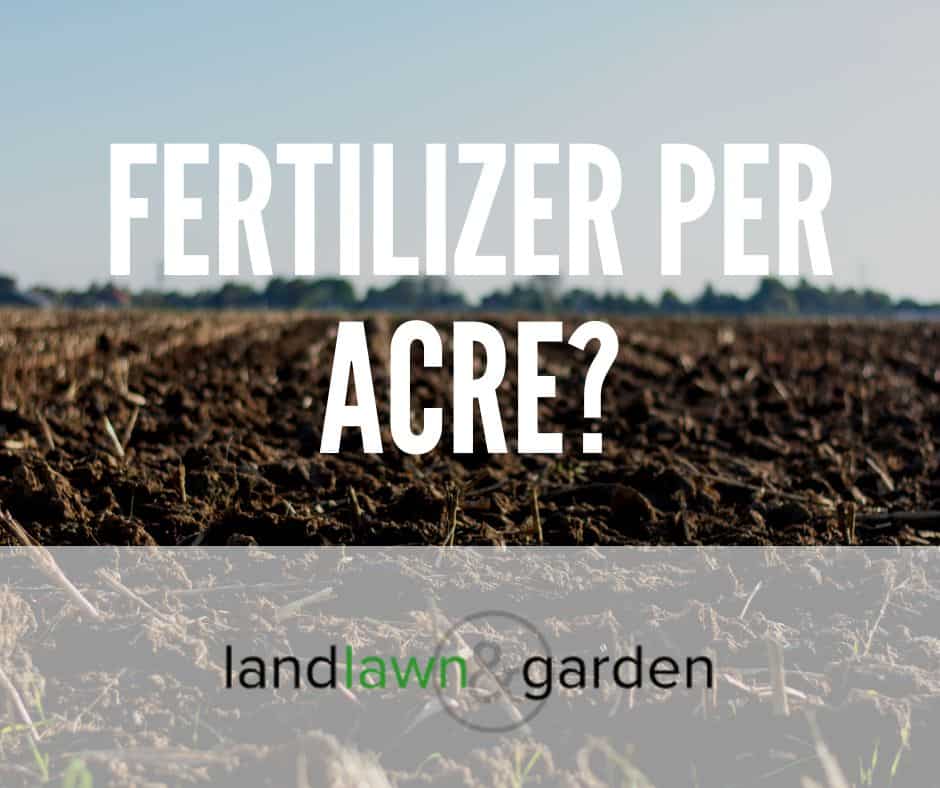To grow healthy, nutritious food plots, you’ll need to ensure healthy soil; nature has a tough time replenishing nutrients in the ground without adding fertilizer. You will be far better off planting a smaller food plot using the right amount of fertilizer than planting countless acres of food plots with inadequate soil, lime, and fertilizer.
In general, approximately 300 pounds of fertilizer per acre of food plot will suffice. However, it’s vital to do a soil analysis to precisely determine what your soil needs. In addition, fertilizers will not work if your soil is too acidic. So, amend your soil with lime before applying fertilizer.
Add a touch of the right fertilizer can quickly put a stop to feeble food plot results. So, let’s discuss exactly how much fertilizer you’ll need per acre of the food plot.
Quick Links
Do You Need Fertilizer For A Food Plot?

Many gamekeepers do not have the exposure or knowledge on how important it is to fertilize food plots. In turn, they devote plenty of time and energy to planting a food plot without adding the vital ingredients to ensure success.
Due to nature’s struggle to replenish nutrients in the soil, plants can seldomly avoid nutrient deficiencies without some help from fertilizers.
In addition, most plants cannot absorb nitrogen directly from the air, making the soil their only possible means of obtaining this essential nutrient. Therefore, plants rely on fertilizers to boost the soil’s nitrogen levels.
Whereas phosphorus might exist in numerous rocks; however, it needs to be water-soluble for plants to access its nutrition. So, using a high-quality phosphorus fertilizer will aid the plant in absorbing it, promoting growth and higher yields.
Likewise, potassium sources are readily available in the soil, but most of the high concentrations occur far beyond reach for the plant’s roots. Therefore, potassium fertilizers will encourage proper plant growth.
To boot, plants require 17 nutrients to thrive, with nitrogen (N), phosphorus (P), and potassium (K) being the three macronutrients. So, the type of fertilizer suitable for your food plot solely depends on the soil quality and variety of crops you are planning on growing.
Many food plot growers tend to use NPK compound fertilizer to supply a combination of nutrients all at once.
Apply Fertilizer To The Correct Soil
Before applying the first available fertilizer to you amend your soil, it’s vital to understand that your fertilizer won’t work as effectively if your soil is acidic (a low pH). The reason being, acidic soil tends to bind the nutrients into the soil, making it near impossible for the plants to extract. You’ll be shocked at how much fertilizer goes to waste with highly acidic soil.
I highly recommend doing a soil analysis before choosing a suitable fertilizer for your food plot.
If your soil pH is too low or acidic, consider adding lime to increase the pH. Fortunately, lime is a cheap fix to alter your soil’s acidity levels.
Some food plot growers even go as far as to say, if you don’t have money for fertilizer and lime, buy the lime.
Lime will make the bound nutrients in the soil available to your plants grown on the food plot and increase the absorption of nutrients supplied by the fertilizer.
What Kind Of Fertilizer Do I Need For A Food Plot?
After amending your soil with lime, you’ll need to consider what type of fertilizer to use on your food plot. In addition, fertilizers have various solubility levels (how much of the fertilizer will dissolve in water).
The solubility of fertilizer is essential as it strongly affects how much of the fertilizer’s nutrients are available to the plants. So, be sure to check the fertilizer’s solubility before purchasing it.
Here are the most common types:
Nitrogen Fertilizer
Nitrogen is the most crucial element for a plant to grow and to photosynthesize. Therefore, high nitrogen fertilizers quickly increase the growth of non-legume plants.
Consider using nitrogen fertilizer for non-legume crops that require high amounts of nitrogen. With the right level of nitrogen, the growth and protein levels of crops will increase.
Note that overusing nitrogen fertilizer can cause soil acidity, preventing other nutrients from reaching the crops.
Phosphorus Fertilizer
Phosphorous fertilizers enhance crops’ root growth and are essential for reproduction and energy transferral during photosynthesis.
The amount of phosphorous fertilizer your crops need depends on the current phosphorous levels found in the soil test, the soil type, and the type of crop you want to grow. So, fertilize according to your soil test recommendations to ensure optimal plant growth.
In addition, phosphorous is vital for deer in the growth of their teeth and antlers.
Potassium Fertilizer
Potassium fertilizer ultimately increases root growth, stem strength, and water uptake.
The amount of potassium fertilizer will depend on the current potassium levels in the soil test, soil type, and the type of crop you want to grow.
Potassium is vital for nerve and muscle function in wildlife.
How Much Fertilizer Do I Need Per Acre Of Food Plot?

Many food plot growers invest hundreds of dollars in fertilizers to help their food plots grow but aren’t aware of how much fertilizer they really need. As a result, they over-fertilize their fields with the wrong kind or amount of fertilizer, resulting in pollution and poisoning the soil.
The issue is that it’s near impossible to give a general determination of how much fertilizer you’ll exactly need for a food plot. Instead, it vastly relies on your specific soil type and test and the type of crop you want to plant.
However, as a primary recommendation: Apply 300 pounds of fertilizer per acre. Ensure that you do not plow too deeply into the soil!
On average soil apply the following ratios:
| CROP | NITROGEN (N) p/acre | PHOSOPHORUS (P) p/acre | POTASSIUM (K) p/acre |
| CANOLA | 180 pounds | 60 pounds | 60 pounds |
| CORN | 180 -260 pounds | 105 pounds | 190 pounds |
| SORGHUM | 80 pounds | 60 pounds | 60 pounds |
| BARLEY | 60 – 100 pounds | 40 pounds | 40 pounds |
| OATS | 60 – 100 pounds | 40 pounds | 40 pounds |
| RYE | 40 – 60 pounds | 40 pounds | 40 pounds |
| WHEAT | 60- 120 pounds | 40 pounds | 40 pounds |
| SOYBEANS | 0 pounds | 40 pounds | 80 pounds |
| SUNFLOWER | 80 pounds | 60 pounds | 60 pounds |
| ALFALFA | 0 pounds | 130 pounds | 200 pounds |
| CLOVER | 0 pounds | 0 pounds | 50 pounds |
| CHICORY | 180 pounds | 60 pounds | 80 pounds |
| CABBAGE | 175 – 200 pounds | 150 pounds | 150 pounds |
| KALE | 175 – 200 pounds | 150 pounds | 150 pounds |
| CAULIFLOWER | 175 – 200 pounds | 150 pounds | 150 pounds |
| BROCOLLI | 175 – 200 pounds | 150 pounds | 150 pounds |
| RADISH | 90 – 120 pounds | 80 pounds | 90 pounds |
To give you an idea of the NPK ratios, look at the following examples:
- Brassicas prefer 20-20-20 types of fertilizer before planting, with a later 45-0-0 fertilizer as plants emerge.
- Before planting, grains prefer 13-13-13 or 20-20-20 fertilizer mixes, with a 33-0-0 fertilizer every four to six weeks.
- Clover prefers 0-20-20 fertilizer before planting, with a 0-0-50 to boost the potassium.
Getting the perfect fertilizer equation also includes knowing what crops were planted in prior years and what fertilizer was used. So, keep in mind that trial and error are part of growing the best food plot.
Wrapping Up
The danger of not using fertilizer when growing food plots is that the plants quickly run out of nutrients and do not have enough “fuel” to thrive to maturity.
However, it’s essential to do a soil test before purchasing fertilizer. Fertilizer won’t work effectively on acidic soil as it binds all the nutrients, making it inaccessible.
After testing your soil, apply the correct fertilizer to ensure your soil creates the optimal environment for your crops to thrive.

Kevin is the owner of Land Lawn & Garden. In addition to taking a lot of pride in his lawn at home, he also helps manage the family land. You can find more about him here.

